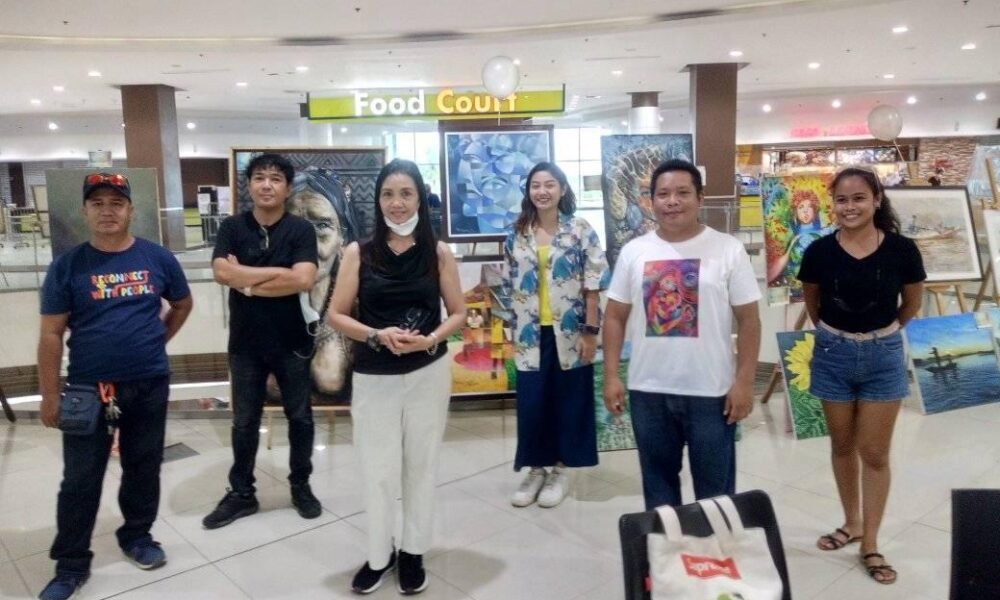
I was strolling aimlessly inside Robinsons Place-Roxas when I noticed an art exhibit. I went over the various art pieces. A question came to my mind: What do painters (read artists) do during the Covid-19 lockdown?
Can a painter, in the truest sense of creative artistry, be a captive of his immediate experience and does nothing to link it with fresh meaning in this present, challenging times?
Vincent Van Gogh said, “if you hear a voice… you cannot paint, then by all means paint, and that voice will be silenced”. ‘Art has a voice – let it speak”, Rochelle Carr asserted. “The principles of true art is not to portray, but to evoke” [Jerzy Kosinski].
I was looking for an “artistic link” evoked in those art pieces. The line of questioning I asked six painters of the October 9 exhibit were all calibrated to evoke such a link.
By chance, I met Ms. Edalyn Acta and requested her to arrange for a brief interview about the exhibit and the featured painters. Edalyn and I agreed to cover the exhibit and write a review on it later.
Mrs. Vallar, a leading resident of the group, provided us with a brief background. The October 19 Exhibit, according to her, is “a project of the Arts Association of Capiz, formerly known as the Capiz Arts Council, founded in 2009. It’s an “open theme,” she added.
The association is better known as the Tinduag Capisnon which did similar arts exhibits in Gaisano Mall, City Mall and at the Villareal Stadium.
Three art pieces caught my attention, while Edalyn also focused on other paintings. These include “Bad Obsession” [abstract] by Eric Delfin, Jenelyn Jore’s ‘Kagat” [of the Crabs, acrylic oil], and Marty “smart” Garbo’s “Panubok,” a side portrait of a Panay Bukidnon.
Eric Delfin saw no drastic changes on subjects or thematic contents despite the lockdown. “Amo man dyapon nagareflect sang style kag balatyagon (feelings or emotions).., daw sa wala man impact sa arts diri ang pandemic experience”. Ang challenges subong sang mga painters amo ang kulang sa exposure, making new paintings. Sige dapat ang research sang mga painters and improve on their craft.”
In Bad Obsession, Eric lavished it with black comprising almost 1/3 of the entire art piece, suggesting the mysteries and secrets than resonating with an aura of subject persons possessed with dignity and sophistication.
Eric uses no primary colors and opines that black is attractive. The painting, he intimated, is s “naughty” not on a morbid scale. “Ihutik ko na lang” (to whisper).
Gray appears to divide the colors black at the upper right and lower left of the canvas, which comprises the painting’s message to the audience thus, hints caution in appreciating a sense of peace in the subconscious play up of the audience.
Though darker inside, gray takes the rectangular form which may tell the manly traits of the painter as he tends to explore and reconnect with negative peripheral elements of life represented, such as stress and anxieties out there.
With the brush strokes slanted toward the left with a figure-like pair of eyes surrounded by hues of light brown, the movement of light on the canvass is less punctuated. It lurks on the non-rational nostalgia of the artist as he tends to grapple with the calm and soothing respite needed to produce continuity or steadiness in such craftsmanship.
In his “Old Man’s Dream,” Eric Delfin depicts a group of trees, without prominence of neither leaves on branches nor dried leaves on the ground. A foot road is accentuated, introducing fairly a perspective in the painting. The colors green and brown are tightly woven to project the artist’s message in his own words, madamu pa kag malayu pa ang makadtuan.
The title “Old Man’s Dream” paradoxically contradicts the artist’s own “conscious” self when he discloses that this painting is a tribute to all mothers.
Jenelyn Jore, another featured painter, is a 24-year-old from Sigma. She started painting during her elementary days. “Hilig ko lang, hobby kag passion ko ang painting,” she stressed. Jenelyn preferred artworks that are “mahipid, indi magamo, and does not employ primary colors, too.* (to be continued).






